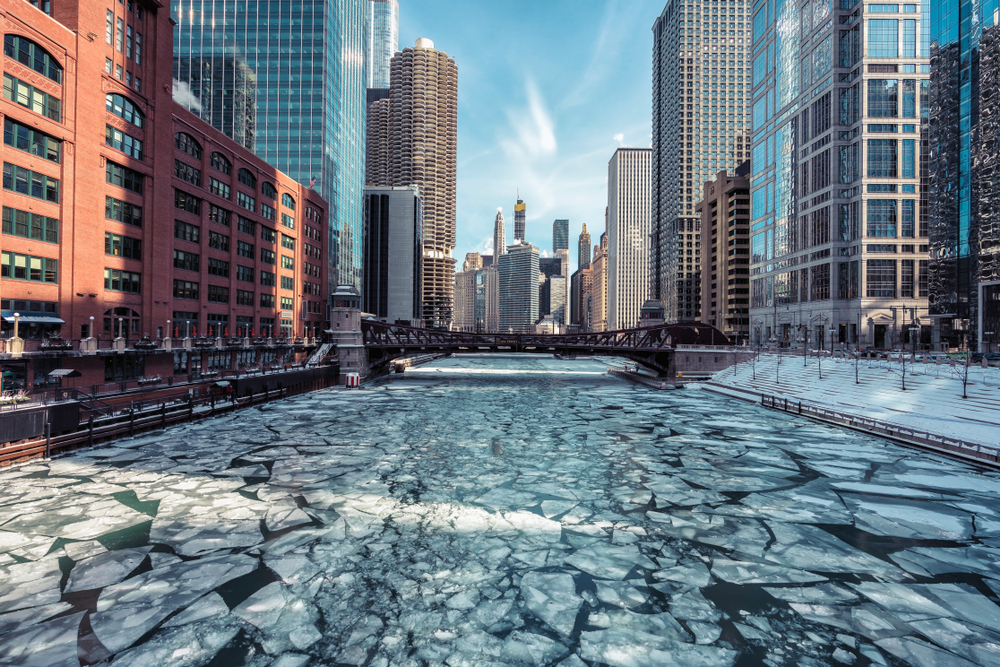our blog

How Cold Is Moving In Chicago?
November 29, 2021
Relocating is challenging enough without the added stress of unpredictable weather. And for this reason, experienced home and business movers in Chicago always factor in seasonal conditions when planning. Preparation is key to a straightforward move, and having contingencies in place helps keep everything on track. Here are some of the major weather factors to consider when moving in Chicago.
Seasonal Moving Advice for Chicago Residents
Illinois features a wide range of drastically different seasons throughout the year. Hot, humid summers are followed by gorgeous autumns filled with colorful leaves but dark, cloudy skies. Then there’s winter. Everyone has an opinion on an Illinois winter, some good and some bad — especially when it comes to spending it in Chicago.
When planning a trip or a move during the cold, blustery season, it’s advised to gain a better understanding of Chicago weather and what you may experience. Snowy Chicago winters have a lot to offer. From snow-topped, picturesque views to magical holiday light displays. Here is a guide on Chicago temperature and snowfall norms as well as some handy tips to improve any snow-covered journey.
Chicago Winter-Weather Statistics
First, let’s start by asking how cold does it get in Chicago? The answer is… it depends. On average, somewhere around 30 degrees Fahrenheit. Highs between 30 – 38 degrees Fahrenheit are typical during the winter months from late November to early March, allowing snow to form, fall and accumulate.
How often does it snow? O’Hare Airport estimates put the average at 28.5 days a year, while the Botanical Gardens just outside the city reports 22.3 days. Usually, Chicago’s first snowfall arrives in November with at least one in four years not recording snow until December. April generally sees the season’s last snowfall, but it usually amounts to less than a quarter inch.
How much snowfall does Chicago see a year? Approximately 37 inches although that average varies drastically by season. For instance, looking at the totals from 2010 to 2019, the yearly average was 42.8 inches over 11.6 days according to a National Centers for Environmental Information (NOAA) report. The heaviest January in the report listed the total at 15.5 inches while the lightest years had five inches or less. It’s safe to say you can’t predict snowfall, only prepare for it.
Tips for Surviving and Thriving During a Chicago Winter Move
Chicago winters can be challenging, but with the right preparation you can stay safe while settling into your new home. From safe driving practices to having fun outdoors, here are some quick pointers for winter living and moving in the Windy City.
- Maintain your car and have it ready to handle wintry road conditions.
- Sustain ample following room when in the notoriously heavy city traffic.
- Store an emergency kit in the vehicle.
- Keep healthy foods on hand to help boost mood and avoid too much take-out.
- Watch the city turn on over a million lights along Michigan Avenue during the Magnificent Mile Lights Festival.
- Check out Chicago’s Christkindlmarket for traditional German food and drinks.
- Take a ride on the Holiday Train.
- Visit the Lincoln Park Conservatory for an escape from the snow.
Advance preparation is key to managing a relocation during Chicago’s challenging winter months. By planning ahead and following a few simple tips, you can make the process more comfortable while your moving team takes care of the packing, loading and transportation. Whether you need apartment movers to simplify a local move or storage services to hold your possessions temporarily, having the right support in place will make the entire process far less stressful.
Ways to Stay Active While Preparing for a Move in Winter
From planning and decluttering to packing and arranging furniture, a relocation can cause significant upheaval in your daily life. With the following tips, you can stay physically active while still completing all necessary moving tasks.
- Make regular plans for physical activity – From joining up with friends for a favorite winter sport to indoor rock climbing, there are many ways to get through the dark days of winter. Not only can these have everyone up and moving, but social activities are a great way to counteract any seasonal depression feelings the long winter may bring.
- Join a gym – It might be too chilly outside to enjoy a jog along the lake but hitting the treadmill at a local gym is always an option. Search your area for a place to get in a workout when the weather turns.
- Enlist a gym accountability buddy – Don’t fall off the wagon using the weather as an excuse. Organizing workout days and times with a partner is a great way to maintain fitness goals.
While you might be tempted to get involved with the heavy lifting yourself, it’s wise to let the professionals provide loading and unloading services for you. As you can see, there are many ways to remain active during a move without putting yourself at risk of injury. Experienced movers are highly trained and use the right equipment to ensure everything goes as planned, without any harm to individuals or property.
Words of Advice on Dressing Appropriately for Moving
Layering
The necessity of dressing in layers cannot be stressed enough. It may seem obvious but the experience of going from a -10 degrees Fahrenheit sidewalk and into a balmy, 72 degrees Fahrenheit room can be jarring to say the least. Brace for it by bundling up against the icy wind in layers so you can peel them off once inside as needed. Layering is also necessary as it can prepare you for any meteorological forecast inaccuracies. Even these trained specialists frequently stop to ponder how bad is winter in Chicago?
Headwear
Whether you prefer a wool or fleece hat, it’s important to cover your head. Use a scarf to keep out the wind, or skip the hassle of wrapping and go with a neck gaiter that doesn’t require continuous tucking in and adjusting. Low-profile earmuffs are another great winter accessory to consider. The essential thing to remember is to conceal your head, ears and neck. Lastly, stock up on lip balm and lotion to help prevent lips and skin from drying out and cracking.
Bodywear
You’ll want to invest in an insulated, heavy-duty — possibly puffy — coat. You won’t be needing it every day, but you will at 10 degrees Fahrenheit below when snow is blowing off the ground and there’s a -20 degrees Fahrenheit wind chill. Zip-out linings and cinch-close cuffs are great features to keep in mind.
For your lower body, jeans won’t typically be enough to keep out the cold. Consider wearing long underwear underneath, wool pants or flannel-lined jeans. Additionally, darker clothing may help hide the wetness and muck from trudging through the dirty snow.
Hands and Feet
Protect extremities with water-resistant, insulated coverings. Lined gloves and mittens are essential. Having a selection of different weights and lengths is a great idea. Same with socks. Heavy, wool socks are wonderful but can get too hot. Having a widespread selection can help you dress accordingly.
While the city is great about snow removal, there are times when you’ll be walking through snow and slush. Invest in watertight winter boots with traction to avoid any slips or falls.
Stay Warm During Your Chicago Move
If you’re organizing a move in the dead of winter, consider hiring professionals who know the terrain and how to handle the hazardous driving conditions. Here at New City Moving, our experienced staff is ready for whatever weather comes their way. Let us help get you through the roughest of cold weather moves. Call 872-314-2148, or schedule your free quote online.
Image Credit –marchello74/Shutterstock.com




 1-872-314-2148
1-872-314-2148



